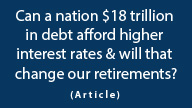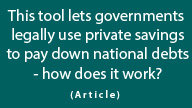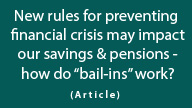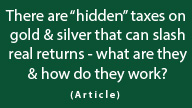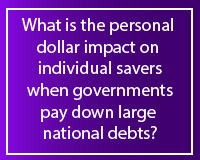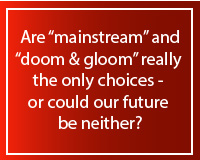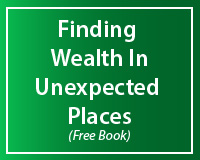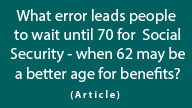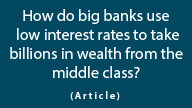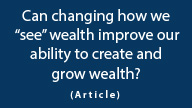Bail-Ins & Real Assets vs Liability-Based Assets
by Daniel R. Amerman, CFA
Below is the 2nd half of this article, and it begins where the 1st half which is carried on other websites left off. If you would prefer to read (or link) the article in single page form, the private one page version for subscribers can be found here:
The Source Of The "Free" Miracle
Now let's more closely examine the real source for this miracle cure for financial crises, which allows for rescues without limit, and which doesn't require raising taxes or increasing the deficit.
We'll do so by considering something most people rarely do, which is what savings really are.
When we make a deposit at a bank, we are taking our assets and providing them to the bank for its use.
What most of us usually don't think about is that the moment that deposit occurs, a new liability is created – for the bank. It's a liability simply because they will have to pay us back. So it is their promise to pay us back – their liability – that is our asset, that is our savings, and is our source of security.
This is how banking generally works – it is all based on OPM, or other people's money. That is, the bank takes people's money in through various means such as savings deposits, checking accounts, certificates of deposit and bonds – each of which becomes a liability for the bank – and it invests that money.
Our money is gone at that point – it has been spent on investments. Those investments, whether loans or securities, then become the assets of the bank.
And traditionally – absent a bail-out – if the bank does a bad job of it and the investment assets become worth less than the liabilities, then the financial institution becomes insolvent, everyone there loses their jobs, the shareholder's stock investments get wiped out, and depositors and other lenders (or the bank deposit insurance fund) take a hit.
Now with bail-ins, the drastic shift in the traditional perspective is that it is our assets that are recognized as being the threat to the too-big-to-fail banks.
With the old bail-out paradigm, bankruptcies are triggered by assets falling in value. With the new bail-in paradigm, it's not falling asset prices that cause bankruptcies – but instead it is having too many liabilities that causes the bankruptcy.
And because of the importance of these financial institutions and their extremely powerful political connections, what has been figured out is that governments can deal with the threat of insolvent banks by dealing with the threat posed by their liabilities.
Once we accept that the liabilities which threaten the global financial order are the same thing as our assets and our deposits – then we need to accept that with the new bail-in paradigm, in the event of a major financial crisis things may not work at all like they used to, and it could be our savings that pay the price.
Five Steps To Understanding The Twisted Logic Of Bail-Ins
To help more clearly understand just how completely bail-ins can invert the traditional wisdom when it comes to "safe investments", consider the five steps below.
1. The reason that liability-based assets such as bank deposits, bonds and annuities are considered so very safe for investors – and particularly suitable for older savers – is that the financial institution is absolutely obligated to pay us back.
2. In the event of a crisis, if the financial organization runs into difficulties and no longer has the assets to pay its obligations – then that very obligation to pay us back our money in full directly threatens the survival of the organization.
3. When faced with a global financial crisis, the heavily indebted and financially stressed nations of the world have an overwhelming incentive to prevent a collapse of the financial system – but lack the assets to bail out the financial system.
4. An alternative – and cost-free – method of saving the global financial order is to remove the source of the risk, which is that absolute obligation to pay us all our money back.
5. It may therefore be presented as being in the best interests of mankind for depositors, bondholders and annuity owners to give up their expectations of getting all their money back.
Rethinking Assets & Safety
The global movement towards bail-ins in dealing with financial crisis obviously creates a fundamental conflict between the needs of society in this case, versus decades of almost unquestioned assumptions among the financial community and individual investors.
It also creates a sharp bifurcation between two entirely different categories of assets.
The first category of assets has value in a fundamental sense, but no fixed value. A financial asset like a stock which represents an ownership interest in a corporation is one example.
Tangible assets are another example, where the asset is something we can physically reach out and touch, such as real estate or precious metals.
What they all have in common is that you own an actual asset. What they also all have in common is that you never know for sure what you can sell them for in the future – as the price of the asset is likely to bounce up and down with the markets.
The second category of assets is when somebody – often a large financial corporation – owes you money. This could be a deposit, or a bond, or an annuity. It is the promise to pay you that is the source of value to your asset.
Now we might on a common sense basis say that we would rather own an asset that's real, instead of relying on the promise of someone else to pay us back.
But with the traditional financial theory of recent decades, what have been considered the safest of all assets for investors have been assets that are really the liabilities of other organizations, the promises to pay us back. And the reason they're deemed to be so particularly safe is that this promise to pay us back has a fixed value (in nominal terms at least, before inflation).
We know the principal amount that will be paid to us. And in some cases, we know the interest that will be paid to us. And this is intended to bring a certain amount of security to us when it comes to covering calculated monthly expenses like housing, or food or transportation in retirement.
However there's an inherent assumption with that, which is that it is highly reliable – indeed practically guaranteed – that we will be repaid.
That is, assuming that we're investing our money conservatively, perhaps through a highly rated financial organization, or in using a large mutual fund to achieve a high degree of diversification through our 401(k) accounts – if done properly, it is supposed to be near certain that we're going to get our money back.
But when it comes to preserving the financial order, what has been recognized by the governments of the world is that the cheapest form of financial rescue is quite simply to wipe out the value of some of the liabilities – without going through bankruptcy.
So what this tells us is that when we provide our money to major financial corporations, we may now be inadvertently entering into a direct and powerful conflict of interest, where in the event of crisis the government has very strong financial incentives to rewrite the rules so that we don't get repaid all of our money.
On the other hand, when we purchase a straight-up asset such as real estate, precious metals or stocks – which have fundamental value, and more importantly are not the liability of anyone else– then there is no conflict of interest.
Therein lies the stark contrast between the two categories of assets that may turn out to be the most crucial consideration of all in the years ahead - choosing assets where it is not in the direct financial interests of governments and corporations to reduce the value of our investments in the event of crisis.
Unfortunately, these potentially deep conflicts of interest between governments and investors are not even considered by most conventional investment strategies. To a large extent traditional financial theory is instead basically moving along on inertia and autopilot at this point. We have unquestioned assumptions with regard to the safety and security of the overall financial order that have been driving traditional financial planning for many decades.
Meanwhile, the governments tell us through words and press releases that everything is fine, but when it comes to actions, procedures enabling bail-ins are spreading rapidly around the world because the governments know that's not truly the case.
And what may seem like this minor technical distinction between "real assets" and "liability-based assets" could be one of the major determinants of investment security – or insecurity – for many tens of millions of investors around the world.
(Please note, however, that having a liability outstanding as part of an asset/liability management strategy is 180 degrees different from owning a liability-based asset. Indeed, there are some real assets which if financed with a liability, have the ability to strongly outperform either a liability-based asset or a real asset with no liability.)
 What you have just read is an "eye-opener" about one aspect of the often hidden redistributions of wealth that go on all around us, every day.
What you have just read is an "eye-opener" about one aspect of the often hidden redistributions of wealth that go on all around us, every day.
 A personal retirement "eye-opener" linked here shows how the government's actions to reduce interest payments on the national debt can reduce retirement investment wealth accumulation by 95% over thirty years, and how the government is reducing standards of living for those already retired by almost 50%.
A personal retirement "eye-opener" linked here shows how the government's actions to reduce interest payments on the national debt can reduce retirement investment wealth accumulation by 95% over thirty years, and how the government is reducing standards of living for those already retired by almost 50%.
 An "eye-opener" tutorial of a quite different kind is linked here, and it shows how governments use inflation and the tax code to take wealth from unknowing precious metals investors, so that the higher inflation goes, and the higher precious metals prices climb - the more of the investor's net worth ends up with the government.
An "eye-opener" tutorial of a quite different kind is linked here, and it shows how governments use inflation and the tax code to take wealth from unknowing precious metals investors, so that the higher inflation goes, and the higher precious metals prices climb - the more of the investor's net worth ends up with the government.
 Another "eye-opener" tutorial is linked here, and it shows how governments can use the 1-2 combination of their control over both interest rates and inflation to take wealth from unsuspecting private savers in order to pay down massive public debts.
Another "eye-opener" tutorial is linked here, and it shows how governments can use the 1-2 combination of their control over both interest rates and inflation to take wealth from unsuspecting private savers in order to pay down massive public debts.







If you find these "eye-openers" to be interesting and useful, there is an entire free book of them available here, including many that are only in the book. The advantage to the book is that the tutorials can build on each other, so that in combination we can find ways of defending ourselves, and even learn how to position ourselves to benefit from the hidden redistributions of wealth.


